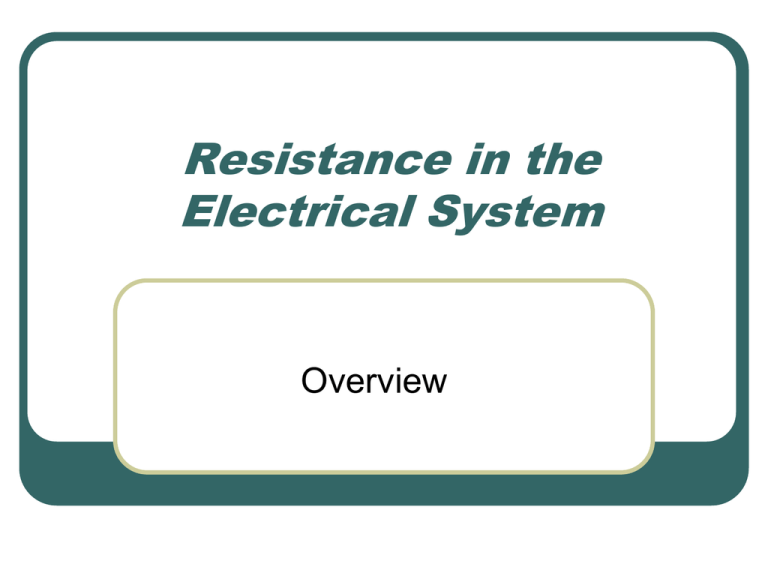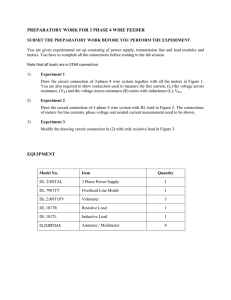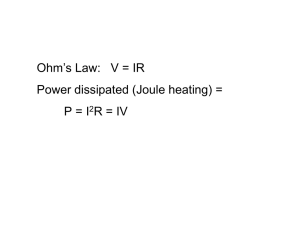Resistance in the Electrical System
advertisement

Resistance in the Electrical System Overview Resistance in the Electrical System 1. What is electrical resistance? - opposition to the flow of electrons in electrical circuits - it is the most important form of resistance in modern technology 2. How do electrons flow in a circuit? - pushed away from the negative end and pulled towards the positive end Resistance in the Electrical System 3. What causes electrons to speed up? - the pull of the positive charge 4. What causes electrons to slow down? - sometimes an electron will collide with another atom in the wire - the electron transfers some of its energy to the atom and slows down Resistance in the Electrical System 5. What is result of this collision? - electrical resistance 6. What is the result of the atom gaining energy from the electron? - the wire will heat up Resistance in the Electrical System 7. What is Ohm’s Law? - Electrical resistance = voltage current -R=V I - also known as V = (I)(R) - V = voltage (volts) - I = current (amps) Resistance in the Electrical System 8. What is the unit for electrical resistance? - Ohms – Greek letter “omega” – uppercase 9. Example – A 100-W light bulb has a current of 0.91 A when the voltage is 110 V. What is the resistance? R=V I - R = 110 / .91 = 120.9 Resistance in the Electrical System 10. What factors effect resistance in a wire? - 1. Length (l) of wire - 2. Area (A) of wire - 3. Material (ρ) of wire (resistivity) Ref Table 4-2/p66 RE l A Resistance in the Electrical System 11. What is the effect of the length of the wire? - the longer the wire, the greater the resistance 12. What is the effect of the area of the wire? - the larger the area, the lower resistance Resistance in the Electrical System 13. How can you classify materials based on their resistivities? - all materials can fit in one of three categories - conductors, semiconductors, and insulators Resistance in the Electrical System 14. What is a conductor? - material with low electrical resistance - electricity can easily flow - these materials have several loosely bound electrons that can travel through the wire - Ex. Copper (1.724), silver (1.59), gold (2.44), solder (tin & lead) Resistance in the Electrical System 15. What is an insulator? - material with very high electrical resistance - electrons are tightly bound to atoms, preventing the flow of electricity - Ex. Glass (1 x 1020), plastics, rubber, ceramics Resistance in the Electrical System 16. What is a semiconductor? - material with a mid range electrical resistance - electrons are bound stronger than conductors, but looser than insulators - impurities may be added to increase or decrease there resistance - Ex. silicon, germanium, gallium arsenide - used in transistors, microchips, and integrated circuits Resistance in the Electrical System 17. How do you add resistors in series? - in a series circuit, there is only one path for current to travel - current must travel through all the resistors, so the resistance must be added together - RTOT = R1 + R2 Resistance in the Electrical System 18. What rules must a technician follow for series circuit? 1. Total resistance = sum of individual resistors 2. Current through each resistor is the same as the current through the whole circuit 3. Sum of each of the voltages across the resistors equal the voltage of the battery Resistance in the Electrical System 19. How do you add resistors in parallel? - in a parallel circuit, current can flow along more than one path resulting in greater current and lower resistance - (1/RTOT )= (1/R1) + (1/R2) Resistance in the Electrical System 20. What rules must a technician follow for a parallel circuit? 1. Total resistance is less than the smallest resistance 2. Total current is the sum of the currents through individual resistors 3. Voltage drop is the same across each resistor. It’s equal to the battery voltage Resistance in the Electrical System 21. Why is electrical resistance important in technology? - resistance controls the amount of current that flows - controlling resistance gives us the power to control current flow Resistance in the Electrical System 22. What are some examples of devices that use resistance to perform? - light bulb – energy gained from electrons is converted into light - radio – volume control increases or decreases the current - soldering iron - computer chips






